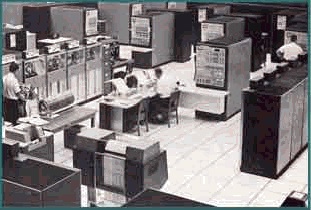| Title: |
EARLY COMPUTERS IN AIR TRAFFIC CONTROL |
| Speakers: |
John Smith, Neville Evans, and Ben Trethowan |
| Date: |
19th May 2011 |
| Time: |
14.30 Room open in advance (from 14.00) – meet up with society members. |
| Location: |
Fellows Library of the Science Museum, Exhibition Road, London, SW7 2DD |
|

The 9020D Machine Room at West Drayton in the 70s |
About the seminar
Air Traffic Control is one of the most demanding and challenging of all computer applications. Systems have to run reliably 24/7 and response times are critical. In this seminar speakers who were involved in the earliest applications will describe their experiences: John Smith who led the team that supported the introduction of the IBM 9020D system into the UK ATC environment and Neville Evans who worked on the early software.
John will describe the events that lead up to the decision to acquire the 9020 system from the US Federal Aviation Administration after the original Marconi Myriad system proved inadequate due to memory limitations.
Neville will describe how IBM 360 machines were adapted to produce a reconfigurable multi-processor system, then go on to outline the workings of the operating system, especially written for this tough real-time application, followed by a brief review of the application software, and finally a description of what controllers saw on their displays.
In order to give a complete picture of the UK ATC system as it was at the London Air Terminal Control Centre (LATCC) West Drayton in the seventies, the seminar will also include material on the Independent Radar Investigation System (IRIS), now located at The National Museum of Computing at Bletchley.
Based upon a DEC PDP-11 infrastructure with Plessey modifications; IRIS was tasked with the investigation of air accidents, reconstructing what controllers saw on screen in real-time playback.
Ben Trethowan, a volunteer who has been heavily involved in the restoration of IRIS, will describe the IRIS system in detail; its role in the wider LATCC operation, its decommissioning, and the challenges of its restoration.
Click  to see a podcast of the event
to see a podcast of the event
|
|
|
|
